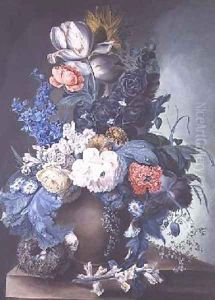Mrs.Margaret Meen Paintings
Margaret Meen, born in 1715, was an English botanical artist and illustrator whose work contributed significantly to the genre during the 18th century. Although not as widely known as some of her contemporaries, Meen was one of the first women to be professionally engaged in botanical illustration. Her contributions were particularly notable at a time when the scientific study of botany and the art of depicting plants were becoming increasingly important in Europe.
Meen began her artistic career at a time when women's participation in the sciences was generally discouraged, but she managed to carve out a niche for herself. She was one of the first women to be allowed to attend and draw at the Royal Botanic Gardens, Kew in London, which was a significant achievement given the restrictions on women in professional fields during her lifetime. Her work at Kew allowed her to study and illustrate a wide variety of exotic plants brought back by British explorers from around the world.
Her illustrations were known for their accuracy and detail, which made them valuable to botanists who were classifying and studying new plant species. In addition to her work at Kew, Meen also taught drawing and painting. Among her students were members of the British aristocracy, who were interested in botany as a fashionable pursuit.
Meen published a collection of her botanical illustrations titled 'Exotic Plants from the Royal Gardens at Kew', which further cemented her reputation. This work, along with her other illustrations, was highly regarded for both its scientific value and its artistic merit. Despite her contributions, Margaret Meen's name is less recognized than some of her male counterparts from the same period, partly due to the gender biases prevalent in her time.
Margaret Meen died in 1795, leaving behind a legacy of botanical illustrations that continue to be of interest to art historians and botanists alike. Her work is preserved in various institutions and continues to be studied for its historical and scientific significance.
